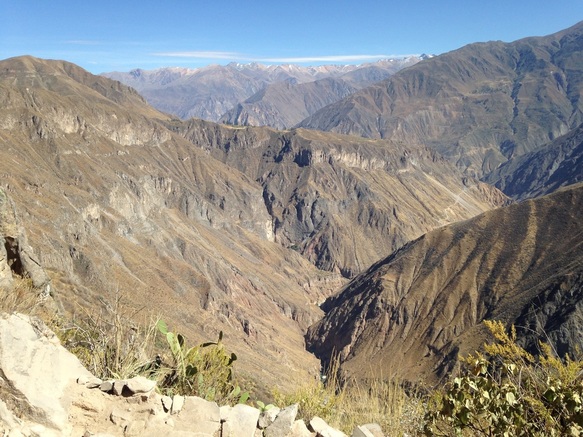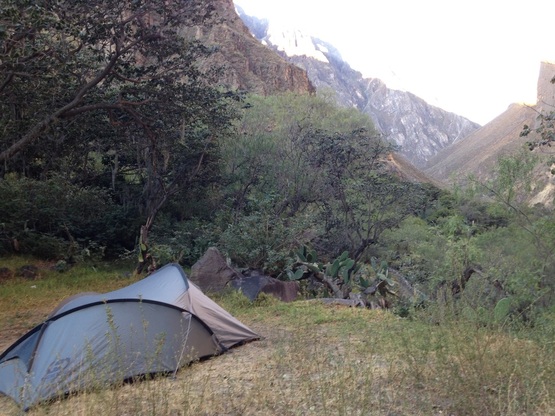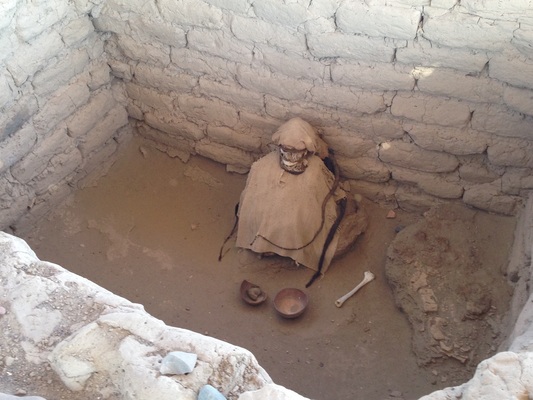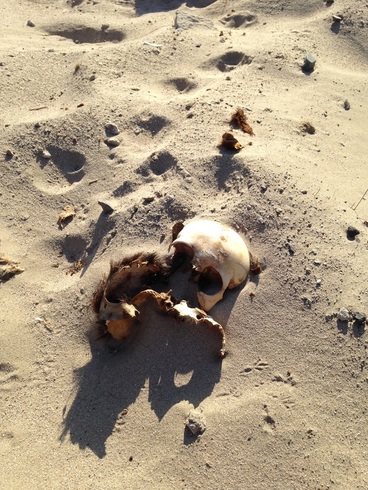|
The Colca Canyon in Southern Peru, with a depth of close to 3300 meters, is one of the deepest in the world. The fact that it is more than twice the depth of the Grand Canyon in the United States is loudly trumpeted among touts and tour-guides in the area. When two French girls we’d met while hiking in Bolivia raved about the Colca trail to us, we thought, “Hey, trekking in the deepest canyon in the world! What could possibly go wrong?” So, with the dream of independently hiking the Colca Canyon, we made our way to the colonial city of Arequipa - which greatly excited Danielle because of the rare Starbucks that make their home there - organized our gear and set out on a local bus to the village of Cabanaconde, perched on the rim of the canyon. After staying overnight, we ventured down into the canyon with our tent, sleeping bags and all our supplies strapped to my back. We had the trail almost entirely to ourselves. As we weaved our way down the dusty trail that lead to the bottom of the canyon and breathed in the cool morning air, we revelled in the natural beauty that surrounded us…and began to realize that it was a long, long, long, long, long trek back up again. We pushed those thoughts to the back of our minds and scrambled down to the bottom. We spent half our trek down gaping in awe at the rocky crags, the pale-turquoise river and condors floating lazily through the sky above us. The other half we spent trying not to stumble and disappear over the edge of a cliff. Danielle tripped and almost fell to her death on a few occasions but, other than that, the journey to the bottom was uneventful.[1] We arrived on the canyon floor and found ourselves alone, sitting in the shade by the river. We couldn’t bring ourselves to continue that day because it was simply too serene to leave. The sound of the river bubbling by paired with the cool shade of nearby trees was irresistible. We began searching for a place to camp. After poking through cactus patches trying to avoid the snakes, spiders and scorpions we knew were lurking, just waiting for the perfect opportunity to strike - in our imaginations at least - we found the perfect spot. We pitched the tent, ate some peanuts and tuna for lunch and settled in for a relaxing afternoon. I don’t remember much about that afternoon except for distractedly trying to prevent a herd of fire-ants from building a home in my leg hair as I tried to read Alistair Reynolds under the shade of a tree. With no light pollution for miles, the sky that night was stunning. Nothing steals my breath away like gaping up in wonder at the millions of stars winking in the sky and remembering just how small I really am. The film of the Milky Way spread across the sky and we both agreed that it was very generous of Mars, Venus and Jupiter to line up so neatly just for us. Our teeth were chattering but it was a night that will be filed under “Permanent & Awesome Memories” in the cabinet of my brain. We trekked over more dusty trails through scenery just as stunning the next day. We paid for a campground in Sangalle with showers and, to our chagrin, a beautiful pool. We had left our bathing suits at home and our clothes were far too dirty to warrant diving in. At least we slept well that night. What goes down must come up. When you’re hiking, the old physics adage works just as well in reverse! On our third morning in the canyon, we woke early, rid ourselves extra food and garbage, purchased four litres of water – “because that’s way more than we’ll ever need” - and began the approximately 3,000 meter climb to the ridge of the canyon. Let me sum up the next four and a half hours for you succinctly: Hardest. Hike. Ever.
Crawling out of the depths of the Colca Canyon made scaling Katahdin in Maine, trekking the hill-stations of Nepal and bouldering up Gross Morne in Newfoundland feel like climbing ant-hills by comparison. It was tough! We don’t have many pictures of that day because we were so focused on breathing and putting one foot in front of the other that we never thought to break out the iPhone! As I laboured up the canyon walls, I began fantasizing about removing my thirty-five-pound pack from my shoulders and heaving it over the edge of a cliff. Our four litres of water had disappeared by the time we were halfway up. The second half of our ascent marked the first time in my life where I was so physically exhausted, I actually pondered how pleasant it would be to collapse in the shade by the trail and die. At least I wouldn’t have to keep climbing that hill! After what felt like an eternity but was really only four hours, we crested the ridge and, to our delight, saw the village of Cabanaconde shimmering in the distance. By that point, I was dangerously exhausted and dehydrated. I may have been hallucinating about small, six-legged purple fur-balls peering at me from behind rocks and screaming “WALLLALLALLAHOOOPAAA!” Or maybe not. The point is, I was thirstier than I’ve ever been in my life. When I stumbled into the first run-down store we could find, a wrinkled Peruvian Goddess of Hydration pointed to a rusted fridge stacked with bottles of cold Gatorade. We ordered five. I sat down and guzzled three, barely pausing to breath. I ordered two more and downed those a little more slowly. All told, I chugged five bottles of Gatorade in less than ten minutes. The purple fur-balls dissipated (or did they?) and, as we trudged to the Arequipa-bound bus, we began to appreciate how great the views had been on our climb out. The final day of the Colca Canyon trek may have been brutal but the scenery there is stunningly beautiful. I’d hike the trails there again in a heartbeat, although, I just might carry more water next time! [1] Just kidding about the “to her death” thing, but not about the stumbling!
0 Comments
Before leaving for our epic trip to Peru and Bolivia, I jokingly told one of my friends in Paraguay that I would be sure to rob an Incan tomb to bring back a “real souvenir.” Looking back, that comment was truly prophetic because, for the first - and hopefully the last - time in my life, I saw what real grave-robbery looks like. For me, the most interesting and thought-provoking experiences in all of Peru (take THAT Machu Picchu!) were unplanned visits to two Nazca burial site. One had been protected and preserved while the other had…not. Chauchilla Necropolis is thought to be one of the largest ancient burial grounds ever discovered in the Western Hemisphere. It is also the only Nazca burial site officially protected by the Peruvian government. The ancient Nazca people mummified and buried their dead here for about seven hundred years, ending in the 9th century AD. The site wasn’t uncovered by Western archeologists until the late 1920’s and, after its discovery, Chauchilla was ruthlessly looted for decades until 1997, when the Peruvian government stepped in to preserve the site further desecration. We decided to visit the well-publicized cemetery one morning on a whim; it’s not often that I search out corpses as part of my travel escapades in foreign countries! We arrived at Chauchilla and found that we had the place to ourselves, with the exception of a French family trailing a teenage daughter who was clearly UNIMPRESSED at her father’s insistence that she traipse around a field of corpses snapping family photographs. “Mais…c’est trés dégoûtant papa,” echoed through the air and was adopted as our quote of the day. Chauchilla was fascinating. While the majority of graves lay undisturbed beneath the sand, a few tombs hiding under the shade of straw huts had been opened for public viewing. The mummies were well-preserved and it was interesting to see the assortment of objects each corpse was interned with, carefully organized around dozens of bodies folded into eternal fetal positions. It was an open air museum like no other! Although a bit run-down, the tombs were tastefully displayed. We were impressed that the Peruvians had done such a good job at protecting the tombs and we were happy to pay the seven-dollar entry fee that covered the cost of security for the site. We wandered around for an hour and decided that we’d had our fill of history for the day. When we arrived back in Nazca, we booked a tour for that afternoon to go sandboarding and dune-buggying in the desert south of Nazca. We chilled drinking coffee and eating far too many churros before setting out with an ensemble of five other people for what we thought would be solely a sand-boarding adventure. As we drove south through the barren hills, it became obvious that human burial sites peppered the desert. Shards of white bone stuck up through the sand and, on a few occasions, I caught glimpses of human skulls, sand drifting through empty sockets, grinning into the piercing blue sky. Our guide suddenly halted the dune buggy at a small necropolis that had been ransacked by grave-robbers with bulldozers two days earlier. He became increasingly agitated as he described the brazen attacks on Nazca’s cultural heritage and outlined his government’s apathy and unwillingness to intervene. “This is legal,” he explained in fiery Spanish. “There is high demand in the Eastern-European market for Nazcan artifacts…people here view robbing tombs as a valid way of making extra money! We need laws to discourage this!” He gave a frustrated wave at the bulldozed sand around the buggy and left us to explore the area. Thus began some of most surreal moments of my life. Dani and I ventured into the churned sand and picked our way through the debris. Pottery shards littered the ground and mixed with decaying clothes, weapons, and bits of wood. Human remains were interspersed with the wreckage; Dani and I treaded carefully, trying to avoid stepping on body-parts. It was a futile effort. I pointed out some colourful bead jewelry hanging from a skeletal wrist that the looters had missed. We could discern different shades of hair-colour hanging from millennium-old scalps. We saw one twisted face so well-preserved that she probably would have been recognized by someone who had known her centuries ago. It is eerie to stare death in the face but unnerving when the dead smile back! I felt something wedged between my toes and gingerly picked a mummified finger from my flip-flop. I decided that I’d had enough. Feeling uncomfortably like a voyeur who spies on something intimately private and personal - I’m not sure I would be stoked about camera-wielding tourists tramping on my remains, even if it is a thousand years in the future - we trudged back to the dune buggy and continued on our way. I still haven’t quite sorted out my thoughts about this; it certainly wasn’t a run-of-the-mill tourist venture and probably not one I could repeat, even if I tried. The logistics of finding a freshly looted mummy-burial-ground would simply be too difficult to replicate! It’s certainly given me a lot to think about though. It also resolutely dispelled the common misconception that tomb raiders wear sexy spandex outfits.
|












